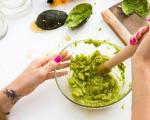How to dye wool black. Dyeing with natural dyes at home
And now about my experiments with painting.
First, general considerations.
Wool for regular dyeing needs to be rewound into skeins. In my experience, it is better not to do more than 100 grams of skein. You need to tie it in several places (I do it in 4), and in a tricky way (I saw this method when I received silk from India - I’m sure that they did and do it with us, but I didn’t think of it myself):
to photo hosting →
I don't have a microwave, so for me painting is boiling in a bowl of dye. In our usual enameled bowl, as practice has shown, it is better not to put more than 200-250 grams of yarn, otherwise it is impossible to interfere normally and the coloring will certainly be uneven. I tried to paint a kilogram at once in 1 large tank - it turned out uneven, because it’s impossible to stir normally, so now I’ll make a section out of it. The yarn must first be soaked, shake well so that it gets wet, and leave for some more time (30 minutes), then shake again. The temperature of the water in which you soak and the water with the dye should be approximately the same, otherwise the wool may sit down (warm, but not hot). After the bowl of yarn is put on fire, you need to stir regularly, but very carefully and slowly, do not chat in any way - it falls off. I was convinced that even fluffy yarns can be dyed, the main thing is to gently mix and after dyeing, let it cool in a natural way, again without talking (I once did such a stupid thing, as a result I spoiled the yarn - now it is more shaggy than it should have been) .
1. Yupi juice and zuko.
We have them, unfortunately, with sugar, so painting with them is not cheap. I dyed it with a mixture of strawberry and cherry zuko (both give a very similar color). We also have peach and orange (yellow and orange tones) for sale. Wool - extrafine merino roving with silk. It was a terrible dirty white-yellowish color. When I saw her, I was terribly upset (I bought it in an online store for a lot of money and there she was white in the photo). With her, in fact, my purposeful saga of buying dyes and figuring out what and how to paint began. Alas, the first pancake, of course, was lumpy - she sat down unevenly (especially a couple of skeins), which is why now she doesn’t look very good. It turned out like this (the colors in life are not quite the same, dimmer):
to photo hosting →
to photo hosting →
The technology is simple. Soak wool. In a bowl of water in which we will paint, add a few tablespoons of table vinegar (I 6 lila, or you can use the essence, with the appropriate dilution) and a few tablespoons of table salt (based on 100g per 1 kg of yarn). Dilute the juice in a mug and pour into the bowl as much as you need (this is determined empirically). Stir it all. Squeeze out the previously soaked wool and throw it into a basin with dye, immediately straighten it carefully and stir it there. Dyes from these juices are absorbed by wool instantly (partially immediately, in just warm water, the rest - when heated). We put the basin on the stove, stir regularly, bring to a boil, boil for 10 minutes or longer (in general, if the dye was not in excess, then the water turned white, and that's it). Usually they also write that at the end you need to add a little more vinegar, for better fixing. After that, remove the basin and leave to cool. Then the wool must be rinsed, wrung out and hung to dry.
2. American juice Kool Aid. The same as ours, only there is no sugar in it and the colors are more diverse. You can buy it on eBay. Here's what I got from that goat down with silk, which I wrote about above, and blueberry juice:
 to photo hosting →
to photo hosting →
It took about 3/4 of a sachet for 200 g for such a coloring (a bag is 3.6 g).
3. Russian-made aniline dyes.
The technology is still the same. The only thing that needs to be dissolved very well and they are recommended to be filtered out (I did not do this).
Here is an example of what they produce from a light lilac Igloo 1857:
to photo hosting →
And this is a painted line-push KLIMT (white with dirty beige spots):
to photo hosting →
Yes, it should be added that the scarlet aniline dye for wool also dyed the cotton threads with which the wool was transported, although, it seems, it should not.
Any thing from frequent use can change its qualities over time, especially when it comes to color. Clothing can fade, rub, stains appear on it. It also happens with woolen things, for example, sweaters or jackets. It is quite difficult to buy a really good product made of natural high-quality wool, since not everyone will be able to afford the price of such clothes. But woolen clothing is practical (warm, soft and cozy), and few of us deny ourselves such a pleasure.
If it’s completely unbearable to part with your favorite thing, you can independently bring the product into proper shape. One such way is to re-dye the sweater. At home, you should use special aniline dyes for yarn or natural dyes, that is, decoctions from the bark of trees, leaves, fruits, flowers, etc.
Dyeing a sweater with aniline dye
One of the most popular ways to restore your favorite little thing to its proper look is to use aniline dye. You can additionally learn about the correctness of your choice from the seller, and choose a really suitable tool. Usually the client selects a shade identical to the product or a color close to it.
How to measure the required dose? First you need to determine the weight of the product in a dry state. If you intend to radically change the color of the sweater, you must first bleach it with Persol. True, such an impact can adversely affect the general condition of the product, since woolen things do not really like radical methods of influencing fibers.
What should be done next? Place the sweater in a bowl of warm water and prepare the dye according to package directions. If you want to give things a more saturated shade, the dosage of the substance can be increased. Add the dye to an enameled container (for example, a deep saucepan), transfer the wet sweater there and boil on the stove. Boiling should be carried out on low heat, constantly turning and stirring the sweater. After 20 minutes of such actions, remove the product from the container, dilute kitchen salt in a bowl with the remaining liquid in proportions of 50 g of crystals per 2 liters of solution, lower the item there again and boil for another 20 minutes.
After turning off the stove, do not remove the sweater from the dish until the dye has completely cooled. Then it needs to be squeezed out, and then rinsed several times in cold water. At the last rinse, a few milliliters of table vinegar are added to the basin (for the final fixing of the paint). When all these steps are completed, gently wring out the sweater, getting rid of excess liquid with a towel, spread the product on a flat surface and leave to dry completely. To prevent the thing from acquiring an unpleasant odor, it needs to be turned over occasionally.
How to dye a sweater with natural dye
To use natural dyes, you first need to prepare a decoction. Crushed plants are boiled in soft water, and then allowed to brew. The next step is this: pour the product you want to color with broth and simmer for about an hour over low heat. After the boiling time has elapsed, leave the sweater in the solution until it cools completely. Then squeeze and rinse in clean cold water (as described above).
Again, you can make a sweater rich black or repaint it from a different color using ordinary alcohol wood stain. To begin with, the product must be washed and rinsed well. We spread the clothes prepared for processing on a flat surface. Getting ready to apply the product: take rubber gloves, a piece of foam rubber and an alcohol substance. The sweater must be thoroughly soaked with stain on both sides. After an hour and a half, the product should be rinsed in running water, squeezed and soaked in a solution of vinegar (200 grams of the substance per 10 liters of water). After 60 minutes of soaking, wring out the product again. Be sure to rinse the sweater several times and dry thoroughly.
Remember that when using any of the indicated methods of painting, there is a risk of hopelessly ruining the thing, so try them only on those sweaters that, if anything, would not be a pity to throw away.
To dye wool (felt) we need:
1. Aniline dye.
2. Saucepan.
3. Measuring cups for paint (you can take plastic disposable dishes)
4. Polyethylene for wrapping wool.
5. Vinegar.
6. Rubber gloves.
7. Syringe.
First, we measure the right amount of wool for dyeing.

Fill the sink with hot water and add some liquid soap. We place the wool in the sink and soak it with hot water for 1 hour.
At this time, we prepare the dye. Buy ready-made dye specifically for dyeing wool.
Expand the wool on the polyethylene.

Wool should not drip.
Use a syringe to draw up the dye.

Multiple colors can be used. However, you need to remember that the colors will mix. And unexpected shades may appear. Remember that some colors mixed together (like red plus green, orange plus blue, purple plus yellow, etc. will all produce some shade of brown).
Fold the plastic around the edges and start rolling it with the wool into a roll.

At this time, boil the right amount of water in a saucepan so that the rukona with wool is completely immersed.

Place the rolls and boil for 45 minutes. Check from time to time to make sure the water hasn't boiled away.
Fill the sink again with hot water and add some liquid soap.

Holding onto the edge of the polyethylene, carefully release the wool into the sink. The polyethylene can be thrown away.
Hold the wool in the sink for 15 minutes and drain the water. Next, you need to rinse the wool (felt) well in warm water and dry it in the washing machine in the drying mode.
Here's what we got!

In addition to vinegar essence, when painting things with acid dyes, ammonium acetate is sometimes used, which decomposes when boiled to form acetic acid (ammonia volatilizes).
When dyeing with such dyes, which are quickly absorbed by the wool, which sometimes gives an uneven and dirty color, ammonium acetate is added, which slows down the dyeing. This is also achieved by adding table salt or Glauber's salt.
To get a more even color, it is necessary to start dyeing at a low temperature and heat the solution gradually. But this method is not suitable for all dyes, some of them give an even color if dyeing is started when the solution is boiling. These include acidic : lightfast yellow, bright blue, anthraquin blue, scarlet, red 2C, bright red, green Zh, black.
The table shows the consumption of dyes per 1 kg of dry material to be dyed.
The tank is filled with water, a weighed amount of sodium chloride or Glauber's salt and acetic essence (acid) are added, having previously diluted it with water. The acid is not added all at once, but first half of the prescribed amount. Then pour in half of the dye, dissolved in a small amount of hot water, and mix thoroughly. The liquid is cooled to 40-45 °, things pre-moistened in water are loaded into it, and within 15-20 minutes. stir with a stick. Then the solution is slowly brought to a boil, which lasts 10-15 minutes. Then things are removed from the solution and cooled to 50 °, after which the second half of the dye solution is added and after 10 minutes. - the rest of the acid. Further, the coloring of things is continued with thorough stirring of the dyeing liquid for 1 hour (with a slight boil).
It is necessary to paint until the water becomes light. Finally, woolen things are taken out, allowed to drain and cooled, then they are first washed in warm and then in cold water.
In the following table we see recipes for dyeing wool with acid dyes (per 1 kg of fabric or yarn)
| Yellow | |
| Methanil Acid Yellow Dye | 10 g |
| Table salt or Glauber's salt | 50 g |
| Acetic essence | 15 g |
| Water | 25 l |
| Bordeaux color | |
| Acid bordeaux dye | 30 g |
| table salt | 50 g |
| Acetic essence | 15 g |
| Water | 25 l |
| Black color | |
| Acid black dye | 40 g |
| table salt | 100 g |
| Acetic essence | 20 g |
| Water | 25 l |

(Instead of table salt, you can take double Glauber's).
If the dye quickly stains the wool, then in order to avoid uneven coloring, dyeing without acid should be started. Instead, ammonium acetate is introduced. First, the dye solution is heated only to 30 °, things are immersed and gradually brought to a boil. If there is still a significant amount of dye left in it, after an hour add vinegar essence and continue dyeing. But at the same time, things should be removed and the solution cooled to 50-60 °.
Color Recipe acid dyes with ammonium acetate (as a percentage of the weight of things):
- dye 1-4%
- acetic ammonium 2-3%
- Glauber's salt 10-20%
- acetic acid 1% of the weight of things
Raw wool products (felted shoes, blankets, etc.) are dyed as follows. Water is poured into cast iron or enameled dishes (30 liters per 1 kg of dry products) and a pre-prepared dye solution is added. Most often, black and brown paints are used - 40-50 g per 1 kg of dry wool. For each kilogram of painted products, 25 g of vinegar essence and 50 g of table salt are added. The pre-cleaned and washed products are lowered into the heated liquid and the solution is gradually brought to a boil. Things should be turned over with a wooden stick. After 30 minutes, lifting the products above the dishes, add another 30 g of vinegar essence, diluted with cold water, and within 30-40 minutes. bring the solution to a boil. Then things are taken out of the boiler and washed first with warm and then cold water.
Wool can also be dyed at home, but for this you need to arm yourself with a certain set of items and special tools:
1. sheep wool (it must be bleached, combed and stretched);
3. table vinegar;
4. Multiple spray guns for different paints;
5. saucepan with a lid;
6. colander, measuring spoon;
7. thick newspaper;
8. polyethylene film.
When painting, follow the basic safety rules: do not give paint to children, do not inhale powder paint, do not use the dishes from which you plan to eat, be sure to wear rubber gloves while working with paint. Remember to follow the precautions that are usually written on the packaging with dyes.
Let's start coloring
1. We prepare a workplace. We cover the table with a two-centimeter layer of newspapers. All nearby objects that are not planned for painting are covered with newspapers. Plastic bags will be needed in order to lay the table on top of the newspapers. Painting will be carried out on a plastic film, in addition, subsequently it will be necessary to wrap the wool in it.
2. Wool is soaked for ten minutes in warm water. At this time, you need to dilute the powder dyes. To do this, pour warm water into a disposable dish, add the dye and stir it thoroughly using a disposable plastic spoon.
3. Dye-powder add in the volume, depending on what color of wool you want to achieve. To get a darker color, add more coloring pigment. For starters, you can try taking 0.5 teaspoon of each color. Using a funnel, pour the dye diluted in warm water into a spray bottle. In the spray bottle you need to add table vinegar - about half a cup. Do not worry about the fact that all components are measured "by eye" - the exact proportions are not important here. If the output is very little coloring liquid or its color is too saturated, add some warm water. You can close the spray bottle and thus dissolve the paint in it, or you can simply mix the contents of the spray bottle with a stick. Dilute the remaining colors in the same way.
4. Remove the wool from the basin, squeeze out excess water from it, straighten it and place it without gaps - with a snake. Spread the wool on the work surface you prepared in advance. Spray the paint with a spray gun over the entire surface of the wool. Dyes need to be sprayed until the wool is completely soaked through with them. Do not be alarmed if you see a small colored puddle under the coat - there is nothing to worry about here.
6. Of course, rolling this bag into a roll, you provoke the pouring of dyes from the wool. However, if your workplace has been equipped in accordance with the above recommendations, then all the excess ink liquid will be absorbed into the thick layer of newspapers.
7. Put the wool roll in a colander, and, accordingly, place the colander on a pot of boiling water. Wool should be steamed for about 20 minutes with the lid closed. After 20 minutes, turn off the stove, the wool should cool. Next, the already cooled wool should be rinsed in warm water until the water becomes clear, colorless.



